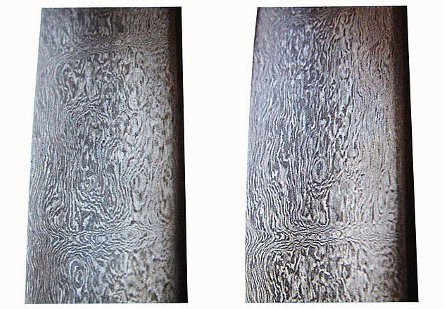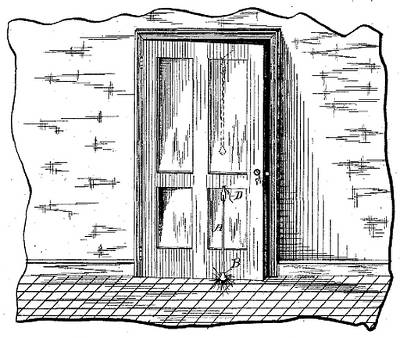
Patented by Zoya Hajianpour in 2004: a “roller for applying sunscreen to one’s own back.”
That’s not as sad as this.

Patented by Zoya Hajianpour in 2004: a “roller for applying sunscreen to one’s own back.”
That’s not as sad as this.

Brooke Pattee’s “night light for a toilet,” patented in 1993, mounts a tube filled with electrical lamps under the upper rim of a toilet bowl so that users can use the bathroom without fumbling in the dark or being blinded by the overhead light.
Blake Warrington’s “toilet seat cover position alarm,” patented in 1989, sounds an alarm if the seat cover is not lowered after the toilet is flushed. “The alarm has the practical effect of conditioning persons who use the toilet to routinely close the toilet seat cover.”

Swords in the ancient Middle East were made of a substance called Damascus steel, which was noted for its distinctive wavy pattern and famed for producing light, strong, and flexible blades. No one knows how it was made.
In defending Constantinople against the Muslims, the Byzantine Empire used something called “Greek fire,” an incendiary substance that was flung at the enemy’s ships and that burned all the more fiercely when wet. But precisely what it was, and how it was made, have been forgotten.
(Thanks, Mike.)


Edwardian journalist Charles Cyril Turner, the world’s first modern aviation correspondent, describes a May morning alone in a balloon over Surrey:
Very slowly I approach a big wood. It would better express the situation were I to say that very slowly a big wood comes nearer to the balloon, for there is no sense of movement, and the earth below seems to be moving slowly past a stationary balloon. … Fifteen hundred feet up and almost absolute silence, broken occasionally by the barking of a dog heard very faintly, or by a voice hailing the balloon, and by an occasional friendly creak of the basket and rigging if I move ever so slightly. Then quite suddenly I am aware of something new.
The balloon has come down a little already, and I scatter a few handfuls of sand and await the certain result. But my attention is no longer on that, it is arrested by this new sound which I hear, surely the most wonderful and the sweetest sound heard by mortal ears. It is the combined singing of thousands of birds, of half the kinds which make the English spring so lovely. I do not hear one above the others; all are blended together in a wonderful harmony without change of pitch or tone, yet never wearying the ear. By very close attention I seem to be able at times to pick out an individual song. No doubt at all there are wrens, and chaffinches, and blackbirds, and thrushes, hedge sparrows, warblers, greenfinches, and bullfinches and a score of others, by the hundred; and their singing comes up to me from that ten-acre wood in one sweet volume of heavenly music. There are people who like jazz!
That’s from Turner’s 1927 memoir The Old Flying Days. Elsewhere he describes approaching the surface of the North Sea far from land: “We could hear the incessant murmur of the commotion of waters as the countless millions of waves and ripples sang together. Surely there is not in nature any sound quite like this, and only in a balloon can it be heard, for by the shore one hears only the turbulent noise of the waters breaking on land, and in any sort of ship the noise of the ship itself makes what to our ears would seem discord.”

John Van Zandt’s “combined cane and burglar alarm,” patented in 1884, is low-tech but effective: The head contains a percussion cap, and the ferrule contains a spring clamp.
“The operation is as follows: The occupant of the room simply takes the cane and suspends the same over the top of the door, as hereinbefore explained. On the door being slightly opened the support for the cane is released, whereupon the cane drops and, striking the floor, explodes the cap, thus frightening away the thief and arousing the occupant of the room.”

I have fully considered the project of these our modern Dædalists, and am resolved so far to discourage it, as to prevent any person from flying in my time. It would fill the world with innumerable immoralities, and give such occasions for intrigues as people cannot meet with who have nothing but legs to carry them. You should have a couple of lovers make a midnight assignation upon the top of the monument, and see the cupola of St. Paul’s covered with both sexes like the outside of a pigeon-house. Nothing would be more frequent than to see a beau flying in at a garret window, or a gallant giving chaos to his mistress, like a hawk after a lark. There would be no walking in a shady wood without springing a covey of toasts. The poor husband could not dream what was doing over his head. If he were jealous, indeed, he might clip his wife’s wings, but what would this avail when there were flocks of whore-masters perpetually hovering over his house? What concern would the father of a family be in all the time his daughter was upon the wing?
— Joseph Addison, Guardian, July 20, 1713

How do you feed newborn pigs when the mother has died or when they are so small or numerous that they may be crushed at feeding time? In 1961 Cora Lee Brown found a unique solution:
One of the important objects of this invention is the provision of a pig feeder designed in the form and size of an actual sow so as to simulate as much as possible the nursing environment afforded by the real animal and to thereby create a natural atmosphere for cultivating the natural eating habits and conditions of the newborn pigs.
In field tests Brown’s invention reduced the mortality rate of newborn pigs. It even plays a recording of the actual sounds of a sow at feeding time, “which operates on predetermined time schedules and is synchronized with the regulated supply of feed to the feeding tank.”

DR. GALL: You see, so many Robots are being manufactured that people are becoming superfluous; man is really a survival. But that he should begin to die out, after a paltry thirty years of competition! That’s the awful part of it. You might think that nature was offended at the manufacture of the Robots. All the universities are sending in long petitions to restrict their production. Otherwise, they say, mankind will become extinct through lack of fertility. But the R.U.R. shareholders, of course, won’t hear of it. All the governments, on the other hand, are clamoring for an increase in production, to raise the standards of their armies. And all the manufacturers in the world are ordering Robots like mad.
HELENA: And has no one demanded that the manufacture should cease altogether?
DR. GALL: No one has the courage.
HELENA: Courage!
DR. GALL: People would stone him to death. You see, after all, it’s more convenient to get your work done by the Robots.
HELENA: Oh, Doctor, what’s going to become of people?
DR. GALL: God knows, Madame Helena, it looks to us scientists like the end!
— From Karel Čapek’s 1920 play R.U.R., which introduced the word robot

Sumter Battey’s surprisingly modern-looking “aerial machine” was patented in 1893. Essentially it’s an aluminum shell filled with hydrogen and bearing a car full of passengers and freight. The shell is fitted with adjustable wings, and the whole thing is propelled by detonating nitroglycerine pellets in the cup-shaped holder on the right, which can be swung back and forth in order to direct the vessel. “The devices for steering, as well as for causing the explosions, are fully under the control of the operator located within the car D.” What could go wrong?

In 1990, as the length of manned space missions began to increase dramatically, NASA’s Richard Haines began to wonder: On an extended mission, how could crew members groom themselves without leaving bits of hair and beard floating about the cabin?
His solution was a clear plastic bubble fitted with slits for a groomer’s hands, as well as a vacuum hose. The same apparatus can be used for almost any grooming task, including haircuts, shaving, and manicures.
“The device may also be used to collect the aerosol droplets of hair spray or small powder residue and the residue of other cosmetics which otherwise would float freely throughout the cabin.”